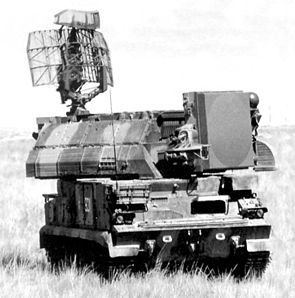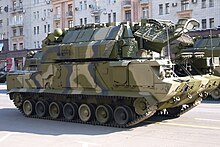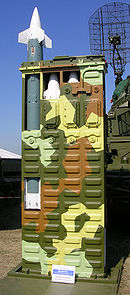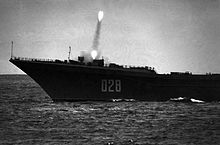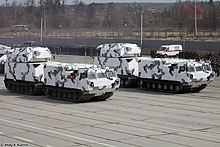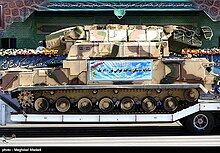9K330 gate
| 9K330 gate | |
|---|---|
| General Information | |
| Type | Surface-to-air guided missile system |
| Local name | 9K330 gate |
| NATO designation | SA-15 Gauntlet |
| Country of origin |
|
| Manufacturer | NPO share / Almas share / cupola |
| development | 1975 |
| Commissioning | 1986 |
| Technical specifications | |
| length | 2.85 m |
| diameter | 560 mm |
| Combat weight | 165 kg |
| span | 750 mm |
| drive | Solid rocket |
| speed | 800-850 m / s |
| Range | 12 km |
| Service ceiling | 6 km |
| Furnishing | |
| steering | Inertial navigation platform |
| Target location | Radar target tracking with radio command steering |
| Warhead | 14.5 kg continuous rod |
| Detonator | Proximity and impact fuses |
| Weapon platforms | 9A330 tracked vehicle |
| Lists on the subject | |
9K330 Tor ( Russian Тор , Latin " Torus ") is a tactical short-range anti-aircraft missile system, the development of which began in the Soviet Union and continued in Russia . The NATO code name is SA-15 Gauntlet . According to the GRAU index , the different versions 9K330 , 9K331 , 9K331M and 9K332 ; those of the guided missiles 9M330 and 9M331 as well as 9M334 .
The system is used to defend ground targets against attacks by fighter planes , helicopters , cruise missiles and UAVs , from low- level flights up to a height of six kilometers. In particular, it can also track and combat small guided missiles or precision bombs that have been fired from higher-flying aircraft. The vehicle can remain in motion and is therefore difficult to hit by such weapons.
9K330 Tor is characterized by high autonomy, accuracy and short response times . This is mainly due to the integration of a modern phased-array target radar in each individual vehicle.
The system is used by the land forces to protect combat units in accompanying missions. It works here in the different distance ranges with the systems 2K12 Kub , 9K33 Osa or their successors 9K37 Buk , 9K40 Buk-M2 , S-300W and S-400 . In some cases, it is also used as short-range and short-range protection for these systems.
function
The 9K330 gate system works fully autonomously, but several vehicles in a group can also be controlled via radio data transmission. Eight missiles are housed in a vertical position in transport / launch containers. The target acquisition has a range of 24 km, the target is fought at a distance of up to 12 km, with a minimum distance of 1000 to 2000 m, depending on the model, and an altitude between 10 and 6000 meters.
The rotating search radar scans the airspace in a radius of 25 km. If a target is identified, the tower is swiveled in its direction and the fire control radar is activated. It works with the phased-array technology, in which beam swiveling and focusing takes place purely electronically and thus without delay and with high precision; the tower only needs to be roughly aligned with the target. The high time and spatial resolution of the target radar creates the conditions for the high accuracy of hits.
The systems can pursue up to 48 targets in parallel and fight two of them at the same time. Objects down to a radar cross-section of 0.1 m² (35 cm diameter when measured from the front) are detected. In the vicinity of strong ECM interference signals, in addition to target tracking via radar, visual control can also be used via a video camera with automatic tracking up to a distance of 20 km.
The reaction time between target recognition and launch of the rocket is given as 5 to 8 seconds when the vehicle is stationary, the reaction time from movement is 10 seconds.
The computer system marks a significant advance over the Soviet technology of its predecessors. It allows a high degree of automation: Approaching targets can be automatically classified according to hazard potential and fought without intervention by an operator. The eight rockets can be reloaded within 10 minutes using a special loading vehicle.
technology
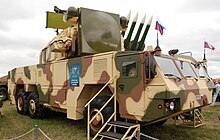
vehicle
Each 9K331 is a tracked vehicle with TELAR function ( English Transporter Erector Launcher And Radar ); it transports and launches the missiles independently. The GM-355 chassis has a mass of 34 t, is 7.5 m long, 3.3 m wide and 5.1 m high with the radar extended. It has a crew of three and achieves with a V12 diesel engine at max. 65 km / h a range of 500 km. The power transmission is hydromechanical , the hydropneumatic suspension enables variable ground clearance. SA-15 can be transported in all weather and by air and is equipped with NBC protection devices for the crew.
A separate gas turbine - generator with 75 kW power allows the operation of the electricity-intensive radar system even when the engine and enables long standby times. In addition to tracked vehicles, there are also versions on trucks , on ships and stationary. There is also a variant that is built on the second vehicle unit of the amphibious and extremely off-road DT-30 .
radar
Two radar systems are mounted on the tracked vehicle :
- Search radar: A 3D pulse / Doppler radar in the E / F band with a range of 25 km, which collects the distance, azimuth and elevation angle (elevation) of up to 48 targets and can track 10 of them in parallel. In addition, the system is equipped with friend-foe detection (IFF). This antenna can be folded in while driving to reduce the cross-section.
- Fire control radar: The phased array system is mounted on the front of the tower, works in the G / H band and can track two targets in parallel with a range of 20 km and combat them with its missiles.
Both radar components are codenamed SCRUM HALF by NATO. A third small antenna is used to communicate with the missiles after launch and prior to target radar acquisition.
rocket
The 9M330 missile is 3.5 m long and weighs 167 kg, the warhead of which 15 kg. The missiles are transported in vertical containers in the center of the carrier vehicle. The start takes place from these. The missile is ejected upwards out of the vehicle by a gas charge. The rocket motor is only ignited at a height of a few meters, which aligns the missile with the target and accelerates it using thrust vector control (gas-dynamic steering) . There is no need to turn the launch carriage in the combat direction, as is the case with conventional systems. A combat vehicle can carry up to 8 9M331 missiles.
The 9M331 missile reaches up to 850 m / s or Mach 2.8. It is remotely controlled from the gate , which tracks the trajectories of the target and missile, via additional pulses in the fire control radar signal and can maneuver with up to 30 g and intercept flying targets with up to Mach 2. The warhead is detonated by a radar proximity fuse. The missile can also be programmed to attack ground targets.
The percentage of hit probability against different targets is given as follows:
- 92-95% - aircraft
- 80-96% - helicopters
- 60-90% - cruise missiles (effective range 5 km)
- 70–90% - precision bombs
- 90% - drones
Versions
Gate, Gate-M, Gate-M1
- 9K330 "Tor" with the 9M330 rocket, minimum range 2 km, introduced in 1986.
- 9K331 "Tor-M" with the 9M331 missile, minimum range 1.5 km, introduced in 1991, with increased accuracy and the ability to fight two targets in parallel.
- 9K331M "Tor-M1" and "Tor-M1T" also with the 9M331.
3K95 "Kinschal" (Russian Кинжал - dagger) is the naval version of the gate, NATO name 'SA-N-9'. It is used on the aircraft carrier Admiral Kuznetsov , destroyers of the Udaloy class and frigates of the Neustraschimy class . This system can control four targets at the same time, with the radar having a range of 45 kilometers. 24 to 64 missiles are set up in groups of eight and are supplemented by a 30 mm cannon for combating anti-ship missiles . Ships of the nuclear-powered Kirov class are equipped with installations of 128 missiles. The marine version of the Tor-M1 is also known as “Jösch” (Russian Ёж - in German hedgehog), the export version as “Klinok” ( Russian Клинок - blade).
In China , the HQ-17 (Hongqi-17) is used as a copy of the 9K331M, where it replaces the old HQ-61 anti-aircraft missile .
Gate-M2
A further development has been underway since the end of the 1990s: Tor-M2 ( 9K332 or Tor-MTA , Tor-MTB , Tor-MTS ) now also has a phased array design as search radar, which works faster and more precisely. With a broad possible frequency range, the radar can react to interference attacks and in turn passively track sources of interference itself. The detection range is now up to 40 km, and the fire control radar now also reaches 25 to 30 km. Furthermore, the hardware and software of the fire control systems are becoming more efficient. Four targets can be fought at the same time with four guided missiles. 16 transport / start containers for the new and more compact guided weapon type 9М334 (9M338KE) are installed in the vehicle . The Tor-M2E system is installed on a tracked vehicle, the Tor-M2K system on an all-terrain 6 × 6 wheeled vehicle. The Tor-M2KM system is a container system that can be stationed on trucks, buildings and ships. The Tor-M2E (K) -simulator 9F678M is installed on an all-terrain truck. All are produced by Kupol , a subsidiary of Almas-Antei . The "Tor-M2DT" version, based on the multi-purpose vehicle DT-30 , was
specially developed for arctic regions . The Tor-M2DT version of the Tor air defense system has been in service with the Russian Northern Fleet since 2018 .
Tor-M2 has a maximum fighting range of 16 km horizontally. The operating altitude is a maximum of 12,000 m. Tor-M2 can pursue 48 targets at the same time and fight four targets up to a speed of 700 m / s.
commitment
The SA-15 system was first used in 1990 and has been continuously developed since then. Tor replaces the 9K33 Osa -Fla missile system (NATO name SA-8 Gecko), which was developed from 1960 and first used in 1971, as well as the Tunguska M-1 system (SA-19 Grison), which was launched from Developed in 1970 and used from 1986.
Accidents
On January 8, 2020, a Boeing 737-800 passenger aircraft en route from Tehran ( Iran ) to Kiev ( Ukraine ) was shot down by a 9K331M-1 Tor-M1 of the Iranian Air Force . According to Iranian Brigadier General Amir Hajizadeh, the passenger plane was mistaken for a cruise missile. There were no survivors among the 167 passengers and 9 crew members.
User states
Current users
-
 Egypt - As of January 2018, there are 10 9K331M in service.
Egypt - As of January 2018, there are 10 9K331M in service. -
 Armenia - In December 2019, Armenia received 2 Tor M2KM installed on a KamAZ-63501 .
Armenia - In December 2019, Armenia received 2 Tor M2KM installed on a KamAZ-63501 . -
 People's Republic of China - There are 24 9K331M-1s in service as of January 2018. Local name HQ-17.
People's Republic of China - There are 24 9K331M-1s in service as of January 2018. Local name HQ-17. -
 Greece - There were 25 9K331M-1s in service as of January 2018.
Greece - There were 25 9K331M-1s in service as of January 2018. -
 Iran - There are 29 9K331M-1s in service as of January 2018, ordered in December 2005 for approximately US $ 700 million and shipped from January 2007 following the purchase of S-300P MU-1 / -2 long-range Systems did not materialize for the time being as a result of protests by the United States.
Iran - There are 29 9K331M-1s in service as of January 2018, ordered in December 2005 for approximately US $ 700 million and shipped from January 2007 following the purchase of S-300P MU-1 / -2 long-range Systems did not materialize for the time being as a result of protests by the United States.
-
 Russia - As of November 26, 2018, at least 292 9К330, 9К331 and 9K332 are in service with the Army .
Russia - As of November 26, 2018, at least 292 9К330, 9К331 and 9K332 are in service with the Army .
Explanation of the Russian air defense formation: 1 regiment "Tor-M2" or "Tor-M2U" ("Tor-M1-2") consists of 4 batteries of 4 vehicles each. This makes a total of 16 vehicles. Meanwhile z. B. 1 department of the same gate versions in turn from 3 batteries for 4 vehicles each. This makes a total of 12 vehicles. -
 Belarus - There are 17 9K332E in service as of January 2018.
Belarus - There are 17 9K332E in service as of January 2018. -
 Cyprus - In January 2018 6 9K332 in service.
Cyprus - In January 2018 6 9K332 in service.
Former users
-
 Azerbaijan - As of January 2018, 9K330 were decommissioned. The planned delivery of 8 9K332E in 2013 and 2014 was therefore not carried out.
Azerbaijan - As of January 2018, 9K330 were decommissioned. The planned delivery of 8 9K332E in 2013 and 2014 was therefore not carried out.
-
 Venezuela - As of January 2018, 12 9K331M-1s were decommissioned.
Venezuela - As of January 2018, 12 9K331M-1s were decommissioned.
See also
literature
Web links
- 9K331 Tor (SA-15 GAUNTLET) at globalsecurity.org (English)
- Defense update with more photos
- Video on YouTube
Individual evidence
- ↑ a b 'Russia delivers first Tor-M1 anti-aircraft missile to Iran' , de.rian.ru , January 16, 2007
- ↑ Ilja Kramnik: New missiles, new possibilities of "Tor". (No longer available online.) Voice of Russia, November 15, 2013, archived from the original on March 4, 2016 ; accessed on November 10, 2015 .
- ↑ a b c SA-15 GAUNTLET / 9K331 gate. In: globalsecurity.org. Retrieved February 8, 2017 .
- ↑ a b TOR-M1 9A331 SA-15 Gauntlet technical data sheet specifications information description pictures UK. In: armyrecognition.com. Retrieved February 8, 2017 .
- ↑ Военнослужащие Северного флота пройдут переобучение на современный арктический вактический вактический -. In: Министерство обороны Российской Федерации. structure.mil.ru, January 17, 2019, accessed on September 4, 2019 (English, among others).
- ↑ Nikolai Novichkov: Tor-E2 SAM system breaks cover. In: janes.com. IHS Jane's, September 3, 2019, accessed September 10, 2019 .
- ↑ Jeremy Binnie: Civil Aviation Organization of Iran confirms Tor-M1s fired at airliner. In: janes.com. IHS Jane's, January 21, 2020, accessed January 27, 2020 .
- ↑ a b c d e f g h The International Institute for Strategic Studies (IISS): The Military Balance 2018 . 1st edition. Routledge, London 2018, ISBN 978-1-85743-955-7 (English, January 2018).
- ↑ Dmitry Fediushko: Armenia receives Tor-M2KM SAM systems. In: janes.com. IHS Jane's, December 24, 2019, accessed January 6, 2020 .
- ^ The International Institute for Strategic Studies (IISS): The Military Balance 2015 . 1st edition. Routledge, London 2015, ISBN 978-1-85743-766-9 , pp. 186 (English, January 2015, at least 120 9K331M / -1, 9K332).
- ↑ Центр АСТ (bpmd): Начаты поставки зенитных ракетных комплексов "Тор-М2". livejournal.com, January 10, 2017, accessed on June 8, 2018 (Russian, among other things in 2015 2 departments were "Tor-M2U" and "Tor-M1-2" and in 2016 2 departments were "Tor-M2 "And 2 departments" Tor-M2U "and" Tor-M1-2 "put into service (a total of 48" Tor-M2U "or" Tor-M1-2 "and 24" Tor-M2 ")).
- Е ↑ Центр АСТ (bpmd): Зенитные ракетные комплексы "Тор-М2" 538-го зенитного ракетного полка в 726-. Бнм укец в 726-. livejournal.com, March 27, 2017, accessed on June 8, 2018 (Russian, including 1 regiment "Tor-M2" (total of 16 "Tor-M2") put into service).
- ↑ Шойгу, Сергей: Плацдармы и рубежи. In: Армейский вестник. army-news.ru, January 11, 2017, accessed on January 1, 2018 (in Russian, among other things, three "Tor M2" departments (total of 36 "Tor-M2") should be put into service by the end of 2017).
- ↑ Мотострелки в Северной Осетии получили новейшие зенитные комплексы "Тор-М2". In: Mil.Press.Bоенное. военное.рф, September 11, 2018, accessed on September 14, 2018 (Russian, including 2 new departments "Tor-M2" (total of 24 "Tor-M2") were put into service).
- ↑ Зенитно-ракетные подразделения мотострелковой бригады ЮВО приняли на вооружение новейшую ЗРС "Тор-М2». In: Министерство обороны Российской Федерации. structure.mil.ru, October 29, 2018, accessed on November 2, 2018 (Russian, including 1 new department "Tor-M2" (total of 12 "Tor-M2") put into service).
- ↑ Первая серийная партия арктических ЗРК "Тор-М2ДТ" прошла военную приемку. In: Mil.Press. FLOT. FLOT.com, November 26, 2018, accessed November 30, 2018 (Russian, including 12 Tor-M2DTs put into service).
- Е ↑ Центр АСТ (bpmd): Зенитные ракетные комплексы "Тор-М2" 538-го зенитного ракетного полка в 726-. Бнм укец в 726-. livejournal.com, March 27, 2017, accessed June 8, 2018 (Russian).
- ↑ Стал известен список военной техники, которая будет продемонстрированa Вооруженными силама пенаными силама анаербо . "Агентство Азери-Пресс (АПА)". June 12, 2013. Archived from the original on June 13, 2013. Retrieved June 12, 2013.
- ↑ Archive link ( Memento from December 5, 2013 in the Internet Archive )
